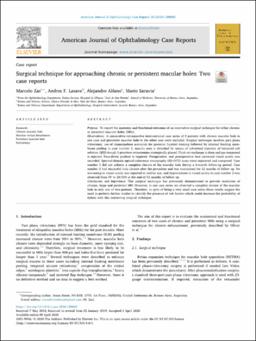| dc.contributor.author | Saravia, Mario. | |
| dc.contributor.author | Zas, Marcelo. | |
| dc.contributor.author | Lasave, Andres. | |
| dc.contributor.author | Et al. | |
| dc.date.accessioned | 2023-12-26T13:33:37Z | |
| dc.date.available | 2023-12-26T13:33:37Z | |
| dc.date.issued | 2020-04 | |
| dc.identifier.citation | Am J Ophthalmol Case Rep . 2020 Apr 9:18:100692. | es |
| dc.identifier.issn | 2451-9936 | |
| dc.identifier.uri | https://riu.austral.edu.ar/handle/123456789/2614 | |
| dc.description | Disponible en: https://www.sciencedirect.com/science/article/pii/S2451993618301725?via%3Dihub | es |
| dc.description.abstract | Abstract
Purpose: To report the anatomic and functional outcomes of an innovative surgical technique for either chronic or persistent macular holes (MHs).
Observations: A consecutive retrospective interventional case series of 2 patients with chronic macular hole in one case and persistent macular hole in the other case were included. Surgical technique involves pars plana vitrectomy, use of triamcinolone acetonide for posterior hyaloid staining followed by internal limiting membrane peeling in case number 1, macula area is detached by means of subretinal injection of balanced salt solution (BSS) trough 3 puncture retinotomies strategically placed. Fluid-air exchange is done and gas tamponed is injected. Face-down position is required. Preoperative, and postoperative best corrected visual acuity was recorded. Spectral-domain optical coherence tomography (SD-OCT) scans were registered and compared. Case number 1 did not achieve a complete closure of the macular hole during a 6-month follow-up period. Case number 2 had successful hole closure after the procedure and was maintained for 12 months of follow up. No worsening in visual acuity was reported in neither eye, and improvement in visual acuity in case number 2 was observed from CF to 20/100 at the end of 12 months of follow up.
Conclusions and importance: This surgical technique has previously demonstrated to provide resolution of chronic, large and persistent MH. However, in our case series we observed a complete closure of the macular hole in only one of two patients. Therefore, in spite of being a very small case series these results suggest the need to perform further studies to identify the presence of risk factors which could decrease the probability of failure with this interesting surgical technique.
Keywords: Chronic macular hole; Macular retinal detachment; Persistent macular hole; Retinotomy.
© 2020 Published by Elsevier Inc.
PubMed Disclaimer | es |
| dc.language.iso | en | es |
| dc.publisher | Elsevier | es |
| dc.rights | Attribution-NonCommercial-NoDerivatives 4.0 Internacional | * |
| dc.rights.uri | http://creativecommons.org/licenses/by-nc-nd/4.0/ | * |
| dc.subject | Chronic macular hole | es |
| dc.subject | Macular retinal detachment | es |
| dc.subject | Persistent macular hole | es |
| dc.title | Surgical technique for approaching chronic or persistent macular holes: Two case reports | es |
| dc.type | Article | es |


